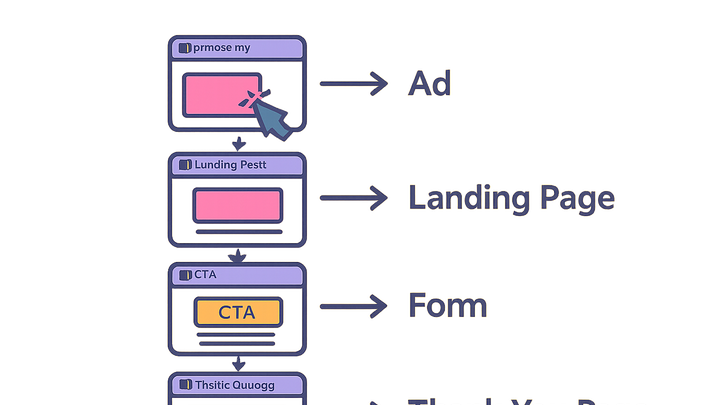Published on 2025-06-29T20:51:50Z
What is a Conversion Path? Examples and Best Practices
Conversion Path is the structured sequence of touchpoints that guides a website visitor toward completing a desired action, such as downloading a resource, subscribing to a newsletter, or making a purchase.
It typically includes:
- Entry Point (e.g., ads, blog posts)
- Landing Pages optimized for conversion
- Calls-to-action (CTAs) prompting user engagement
- Lead capture forms for gathering visitor information
- Confirmation or thank you pages that reinforce the value exchange
By optimizing each stage of the conversion path, businesses can improve conversion rate optimization (CRO), deliver a seamless user experience (UX), and enhance search engine optimization (SEO) through better engagement signals.
Leveraging tools like Prevue.me provides actionable critiques to identify UX friction points, SEO enhancements, and accessibility improvements, maximizing lead generation and ROI.
Conversion path
A series of strategic touchpoints on a website that guide visitors towards completing a goal.
The Importance of Conversion Paths
Understanding why conversion paths are critical for optimizing website performance and achieving business goals.
-
Driving conversions and revenue
Conversion paths directly impact a website’s ability to turn visitors into leads or customers, affecting overall ROI.
-
Enhancing user experience (ux)
Well-designed paths reduce friction and provide clarity, leading to higher satisfaction and repeat engagement.
-
Boosting seo signals
Higher engagement and lower bounce rates along optimized paths send positive signals to search engines.
Core Components of a Conversion Path
Breakdown of the essential elements that make up an effective conversion path.
-
Entry points
These are the channels and content pieces that attract visitors to your site, such as blog posts, ads, or social media.
- Organic search:
Visitors arriving via search engines on SEO-optimized pages.
- Paid advertising:
Clicks from PPC ads or social media promotions driving targeted traffic.
- Organic search:
-
Landing pages
Dedicated pages optimized to persuade visitors to take a specific action.
- Clear headlines:
Express the value proposition immediately.
- Trust signals:
Include testimonials, logos, or security badges to build credibility.
- Clear headlines:
-
Calls-to-action (ctas)
Buttons or links prompting users to move to the next step, such as Download Now or Request a Demo.
- Placement:
Position CTAs where they’re easily visible and relevant.
- Design:
Use contrasting colors and clear text for better click-through rates.
- Placement:
-
Lead capture forms
Forms used to collect user information in exchange for value like eBooks or webinars.
- Field minimization:
Only ask for essential information to reduce friction.
- Progressive profiling:
Gather more details over multiple interactions to avoid form fatigue.
- Field minimization:
-
Thank you pages
Confirmation pages that reinforce the user’s action and guide them to next steps.
- Confirmation message:
Acknowledge the user’s submission and set expectations.
- Additional offers:
Upsell or cross-sell with related resources or products.
- Confirmation message:
Designing Effective Conversion Paths
Best practices for creating paths that resonate with users and drive conversions.
-
User-centered approach
Design based on user needs, motivations, and pain points identified through research and analytics.
-
Mobile optimization
Ensure all steps of the path are responsive and fast-loading on mobile devices.
-
Visual hierarchy and clarity
Use whitespace, typography, and color contrasts to guide the user’s eye to key actions.
-
Personalization
Tailor content and CTAs based on user segments, behavior, or referral source to increase relevance.
Measuring and Optimizing Conversion Paths
Techniques and metrics to assess performance and improve conversion paths over time.
-
Key metrics to track
Monitor click-through rates, form completion rates, bounce rates, and time on page to gauge path effectiveness.
-
A/b testing strategies
Test variations of headlines, CTAs, form layouts, and page designs to identify the highest-converting elements.
-
User behavior analytics
Leverage heatmaps, session recordings, and journey analysis to uncover friction points.
-
Actionable critiques with prevue.me
Use prevue.me to get UX, SEO, accessibility, and conversion-focused feedback that pinpoints improvement areas.
Common Pitfalls and How to Avoid Them
Typical mistakes in conversion path design and practical tips to steer clear of them.
-
Overwhelming users with too many choices
Present a clear, singular next step to avoid decision paralysis.
-
Slow page load times
Optimize images, minimize scripts, and leverage CDN caching to keep pages swift.
-
Vague or weak ctas
Use action-oriented, benefit-focused CTA copy that tells users exactly what to expect.
-
Neglecting accessibility
Ensure forms and buttons are keyboard-accessible and follow WCAG guidelines for inclusive design.
